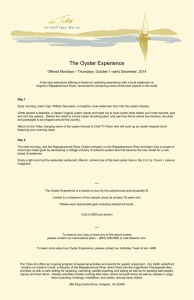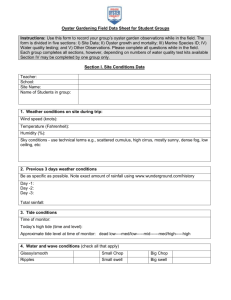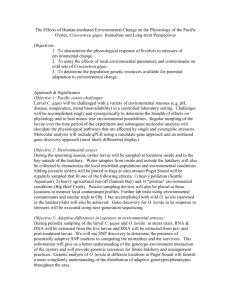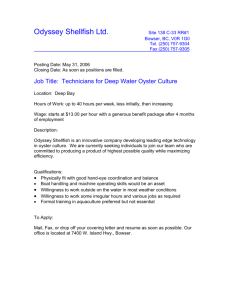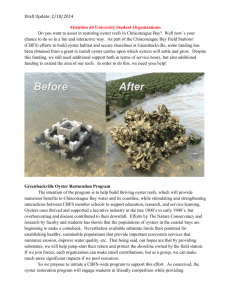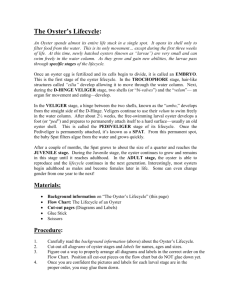Predators, Prey and Invasions in a Warming World
advertisement
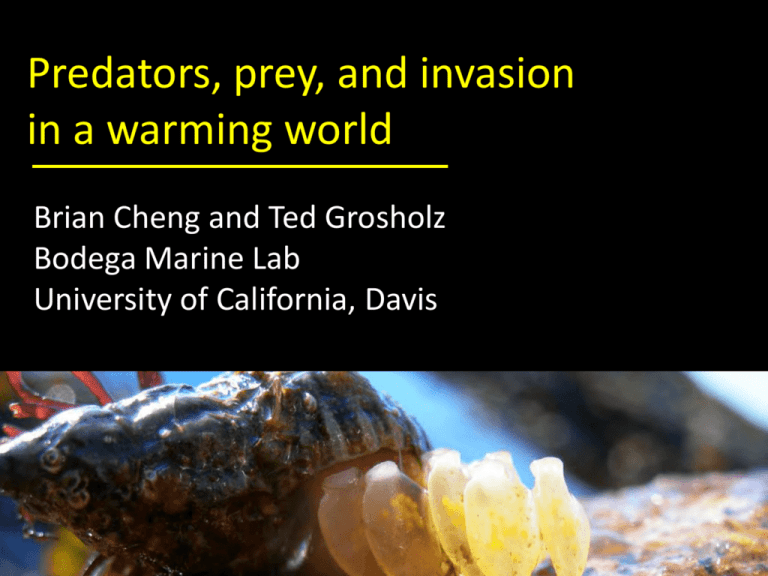
Thermal performance in an invasive Predators, prey, and invasion predator andworld native prey interaction in a warming Brian Cheng and Ted Grosholz Bodega Marine Lab University of California, Davis Olympia oysters: a key species • Ostrea lurida • Historically abundant • Subjected to fishing, sedimentation, etc. • “Foundation” species • Failed recovery • Focus of restoration Baker 1995, Kirby 2004, Kimbro and Grosholz 2006 Oyster Narrative from Townsend CA Dept. of Fish and Game 1893 Eastern oyster drills • • • • Urosalpinx cinerea Predatory snail Native to eastern US 1890s: Introduced to SFB Tomales Bay We are here! Giants dominate here (2x) Oyster declines in Tomales Bay 60 Are native oysters and invasive snails differentially susceptible to warming? Oyster density (m-2) 50 40 30 20 10 0 2002 0 2004 2006 2008 Year 2010 2012 methods • Cultured oysters/snails from Tomales Bay lethal performance • Acute thermo-tolerance trials using aluminum heat bar (n = 30) lethal tolerance 1.0 Oysters Snails Proportional Survival 0.8 Similar lethal tolerance (LT50) 0.6 0.4 0.2 0.0 20 30 Temperature (C) 40 50 sub-lethal performance Growth • Chronic temperature effects across six temperatures (16-30°C) • Measured oyster shell area and snail shell height Feeding • Oyster consumption measured with fluorometry • Snail consumption measured by examining per capita oyster consumption growth 16 Oyster Snail 4.5 2 Oyster shell area (cm ) Field temperatures at oyster optimum! 14 4.0 3.5 12 3.0 10 2.5 2.0 8 1.5 1.0 6 14 16 18 20 22 24 Temperature (C) 26 28 30 32 Snail shell height (mm) 5.0 feeding performance 6 -1 Oysters Snails 5 60 4 40 3 20 2 0 1 0 14 16 18 Snail consumption (oysters 3 days ) Phytoplankton consumption (%) 80 20 22 24 26 Temperature (°C) 28 30 32 summary • Lethal tolerances similar among predator/prey • Oysters have decreased sub-lethal performance at warmer temps relative to snails (evolved under larger thermal window) • Feeding rate is a potential mechanism • Field temps are near oyster optimum implications • What is stressful for natives may not be for invaders • Greater thermal tolerance in invaders may be a general phenomenon Braby and Somero 2006, Schneider 2008, Sorte and Williams 2010 acknowledgements Technicians Jessica Couture Sarah Covello Grosholz Labbies Holly Long David Kimbro BML Eric Sanford Nann Fangue Joe Newman Jill Bible Lisa Komoroske Pacific Coast Science and Learning Center George Melendez Wright Climate Change Fellowship bscheng@ucdavis.edu Multiple stressors and latent effects on Olympia oysters Brian Cheng1*, Jill Bible1, Andy Chang2 Matt Ferner2, Kerstin Wasson3, Chela Zabin2 Anna Deck2, Marilyn Latta4 and Ted Grosholz1 1Bodega Marine Lab, UC Davis 2 San Francisco Bay NERR 3 Elkhorn Slough NERR 4 State Coastal Conservancy Email: bscheng@ucdavis.edu GOAL: Increase resilience of oyster restoration projects in the face of climate change 1. Lab experiments – determine effects of climate stressors and interaction with anthropogenic stressors 2. Field surveys – Characterize stressors at 18 sites in San Francisco Bay and Elkhorn Slough 3. Connectivity – Description of oyster larval dispersal patterns within and among bays 4. Synthesis – analysis of field and lab data in order to index restoration sites Stressors affecting oysters Anthropogenic Stressors Invasive Species Sediment Burial Climate-related Stressors Hypoxia Warming OYSTERS Low Salinity Acidification Elkhorn Slough Elkhorn Slough Dissolved Oxygen (% sat) 200 150 100 50 0 Jun Aug Oct Dec 2010 - 2011 Feb Apr Jun Elkhorn Slough 25 30 20 20 15 10 10 0 Hypoxia/Anoxia 5 Jun Aug Temperature Oct Dec 2010 - 2011 Feb Apr Jun Salinity (PSU) 40 Performance Temperature (C) 30 Multiple stressor studies needed Experimental Approach 30 Phase 2: Recovery (90 days) Performance Temperature (C) 20 10 Phase 3: Low salinity trial (5 days) 10 0 Hypoxia/Anoxia 5 Jun 20 Aug Salinity Outline 30 Phase 1: Temp x DO trial (14 days) 25 15 40 Temperature Oct Dec 2010 - 2011 Feb Apr Jun Questions 1. How do multiple simultaneous stressors affect oyster performance? (temp x DO) 2. Are oysters capable of recovering from these Hypotheses time? will decrease oyster A.stressors Low DOover conditions growth 3. Does early stress affect performance at later B.stages Higher temperatures will enhance the DO in response to low salinity? effecteffect?) by increasing metabolic demand (latent during hypoxia/anoxia Methods • Cultured F1 oysters from adult broodstock collected from San Francisco Bay (May 2012) • Oysters settled on PVC tiles (10x10 cm) Methods • Subjected newly settled oysters to – Temperatures: 20, 24 C – Dissolved oxygen: 0.6, 2.0, 6.5 mg/L • 10 hr nightly low DO for 14 days • Oyster growth measured by shell area (ImageJ) • Lipid/glycogen content Anne Todgham Nate Miller Trial conditions 10 Dissolved Oxygen (mg/L) Normoxia 8 Hypoxia Anoxia 6 4 2 0 12-Aug 13-Aug Date 14-Aug 24 C Normoxia 24 C Anoxia Temperature / DO effects 0.5 Shell Area (cm2) 0.4 1. Low DO results in less growth (up to 3x!) 2. High Temp results in greater growth under normoxia 3. High temp benefits oysters in hypoxia 4. But not in anoxia 20 C 24 C * 0.3 * 0.2 0.1 0.0 1 Normoxia 2 Hypoxia Dissolved Oxygen 3 Anoxia Summary • Multiple stressors are common in the field and timing of stressors with life stage is important • Interactions of stressors may produce surprising results • Low DO results in lower oyster growth • Moderate increases in temp may allow oysters to compensate under hypoxia but not anoxia – Increased feeding rates during daytime normoxia Implications Performance • Restoration success depends on understanding which stressors are important • Threshold responses may be common • Where species reside on thermal response curve will be key 20 24 Temperature Acknowledgements Technicians Charlie Norton Chris Knight Emily Seubert BML Joe Newman Karl Menard Philip Smith Questions? Brian Cheng bscheng@ucdavis.edu


